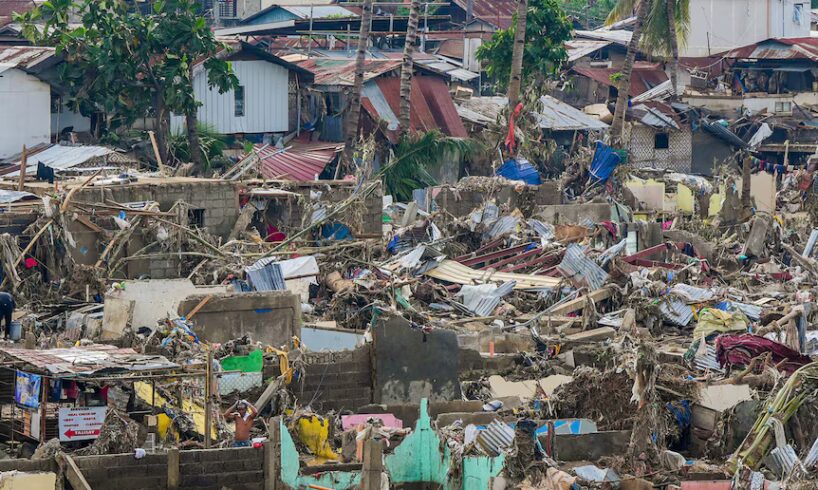
Typhoon Kalmaegi brought fierce winds and torrential rains to Vietnam on Friday, killing at least five people, flattening homes, blowing off roofs and uprooting trees.
In the Philippines, where the storm left at least 204 dead earlier in the week, survivors have wept over the coffins of their loved ones as they brace for another typhoon.
As the storm moved on, recovery work began in battered towns and villages in both countries.
Across central Vietnamese provinces people cleared debris and repaired roofs on their homes.
Jimmy Abatayo, who lost his wife and nine close relatives after the typhoon unleashed flooding in the central Philippine province of Cebu, was overwhelmed with sorrow and guilt as he ran his palm over his wife’s casket.
“I was able to swim. I told my family to swim, you will be saved, just swim, be brave and keep swimming,” the 53-year-old said, breaking into tears.
“They did not hear what I said because I would never see them again.”
Mourning the dead in the Philippines
In Cebu 141 people died, mostly due to flooding.
On Friday villagers gathered to farewell the dead, including at a basketball gym where relatives wept before a row of white coffins bedecked with flowers and small portraits of the deceased.
Relatives and friends were overcome as they farewelled loved ones in Bacayan, in the Cebu province. (AP: Jacqueline Hernandez)
A state of national emergency declared by President Ferdinand Marcos Jr. on Thursday was still effect as the country braced for another potentially powerful storm, Typhoon Fung-wong, known locally as Uwan.
Mr Marcos, who visited Cebu on Friday, said an unusually large volume of rain overwhelmed dykes and flood-control safeguards and caused rivers to rapidly overflow.
Nearby communities were flooded and residents scrambled to climb to the upper floors or roofs of their houses in panic.
Across the country, Kalmaegi left at least 204 people dead and 109 missing, the Philippines Office of Civil Defense said, and more than half a million people were displaced.
Nearly 450,000 were evacuated to shelters and nearly 400,000 remained in evacuation centres or the homes of relatives as of Saturday.
The weather bureau said Fung-wong would arrive early next week and was predicted to span an estimated 1,400 kilometres before making landfall late on Sunday or early Monday in northern Aurora province.
It could also affect the densely populated capital region of Manila.
The toll in Vietnam
State media said five people were killed in Vietnam — three in the Dak Lak province and two in the Gia Lai province.
Three people remained missing in the city of Quang Ngai.
Typhoon Kalmaegi makes landfall in Vietnam
Fifty-two houses collapsed and nearly 2,600 others were damaged or had their roofs blown off, including more than 2,400 in Gia Lai.
Power outages affected more than 1.6 million households.
Factories lost their roofs and equipment was damaged because of flooding in Binh Dinh province.
In hard-hit Quy Nhon, residents woke up to find corrugated metal roofs and household items scattered along the streets.
As the skies cleared and sunlight broke through on Friday morning, Dak Lak residents stepped out to assess the wreckage left behind.
Streets were littered with fallen branches and twisted sheets of metal, and muddy water pooled in low-lying areas where the river had surged to record heights overnight.
Shopkeepers dragged out waterlogged goods to dry in the sun and families swept mud from their doorsteps and patched together missing roof tiles.
Many areas in Vietnam reported uprooted trees, damaged power lines and flattened buildings as Kalmaegi weakened into a tropical storm and moved into Cambodia on Friday.
Tropical cyclones slamming the region
Kalmaegi struck Vietnam as the country’s central region continued to reel from floods caused by record-breaking rains.
Authorities said more than 537,000 people were evacuated, many by boat, as floodwaters rose and landslides loomed.
The storm was forecast to dump up to 600 millimetres of rain in some areas before moving into Laos and north-east Thailand.
Three fishermen were reported missing Thursday after their boat was swept away by strong waves near Ly Son Island off Quang Ngai province.
Search efforts were later suspended due to worsening weather, state media said.
There was severe flooding in Dak Lak on Friday. (AP: Hau Dinh)
The Philippines experiences about 20 typhoons and storms per year and is among the world’s most disaster-prone countries.
Vietnam, which is hit by about a dozen storms annually, has endured a relentless series this year.
Typhoon Ragasa dumped torrential rain in late September, followed by Typhoon Bualoi and Typhoon Matmo, which together left more than 85 people dead or missing and caused an estimated $2.1 billion worth of damage.
Scientists warn that a warming climate is intensifying storms and rainfall across South-East Asia, making floods and typhoons increasingly destructive and frequent.
Kristen Corbosiero, a professor of atmospheric and environmental sciences at the University at Albany, said a normal year would have 23 named storms by this time, but Kalmaegi and Fung-Wong are the 26th and 27th.
She said Kalmaegi was the fourth-strongest typhoon this season.
“If you look at the climatology for the Philippines and for Vietnam, it’s almost the entire year that they can get them, because the warm waters that fuel the storm just are there,” Dr Corbosiero said.
AP





